|
ANTIETAM National Military Site |
 |
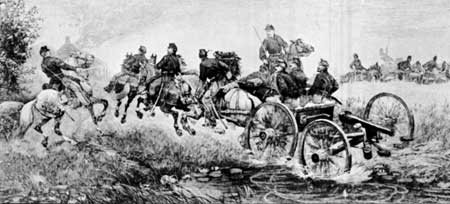
Going into Action.
From etching by W. H. Shelton. Courtesy, Library of Congress.
Jackson Prepares an Ambush
By 9 a.m., 3 hours of killing had passed. The Miller cornfield had become a no-mans' land, its tall stalks trampled to the ground and strewn with blood-soaked corpses. Firing had been so intense, had so fouled the men's muskets, that some of them were using rocks to pound their ramrods home.
Jackson was in extreme danger. Green's Federals still lurked near the Dunkard Church, waiting only for support to renew their attack on the frayed Confederate line. And at this very moment a mass of blue-clad infantry could be seen emerging from the East Woods half a mile away—it was part of Sumner's II Corps moving up for the morning's third major Federal attack.
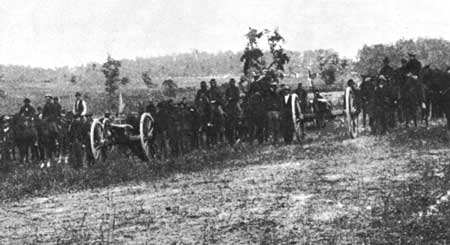
Knap's Independent Pennsylvania Battery "E" supported Mansfield's corps
Courtesy, National Archives.
Swiftly Jackson gathered together reinforcements from other sectors of the battlefield. Some had just arrived from Harpers Ferry; these were McLaws' men. With hardly a pause they moved north and disappeared into the West Woods. Lee ordered Walker's two brigades north from the Lower Bridge; they too disappeared into the West Woods. Thus they came, racing from far and near.
For a moment, the fighting ceased. Then powerful reserves were rushed forward by commanders of both armies to renew the battle.
As soon as they came in, Jackson craftily placed these men behind the rocks and ridges at the western fringe of the woods. Soon they formed a great semicircle whose outer points perfectly encompassed the 5,000 men in Sumner's approaching column. Ten-thousand Confederates were there. Now they disappeared into the landscape and waited.
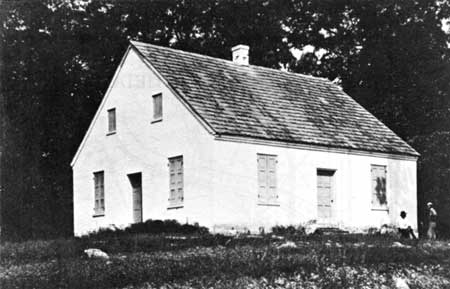
Closeup of Dunkard Church where Greene's men were halted.
From Gardner's Photographic Sketch Book. Courtesy, Library of
Congress.
Sumner's II Corps, under orders to support the attack on the Confederate left, had prepared at dawn to cross Antietam Creek at Pry's Mill Ford. Impatiently, Sumner had awaited the signal to march while the battle raged with increasing violence on the ridge beyond the stream. Finally, at 7:30 a.m., he led Maj. Gen. John Sedgwick's division across the ford. Brig. Gen. William French's division followed, but soon drifted to the south and lost contact with Sedgwick.
Believing that he still led two divisions, Sumner continued his march past the East Woods. By now he knew that the earlier Federal attackers could give him no support, but he believed that the Confederates who had repulsed them must be equally exhausted and disorganized. Striking now—immediately—he might turn the tide before the enemy had time to recover. In his hurry, Sumner neglected to make sure that French's division followed closely in his rear. Neither had he taken time to reconnoiter the Confederate front in the West Woods.
Soon after 9 a.m., Sedgwick's heavy column, with Sumner at the head, started toward the Hagerstown Pike. Battleflags waving, bayonets glistening, the division marched forward in brigade front—long swaying lines of two ranks each.
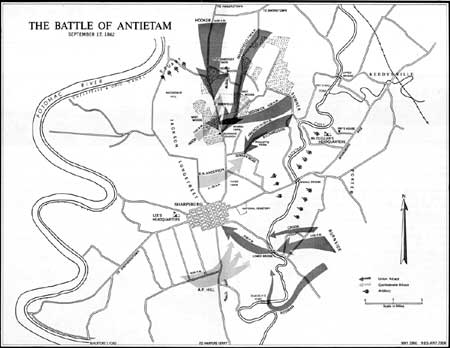
(click on map for an enlargement in a new window)
Unmolested, they crossed the pike and passed into the West Woods. Almost surrounding them were Jackson's quietly waiting 10,000. Suddenly the trap was sprung. Caught within a pocket of almost encircling fire, in such compact formation that return fire was impossible, Sedgwick's men were reduced to utter helplessness. Completely at the mercy of the Confederates on the front, flank, and rear, the Federal lines were shattered by converging volleys. So appalling was the slaughter, nearly half of Sedgwick's 5,000 men, were struck down in less than 20 minutes.
But the trap had not been completely closed. In the confusion of the surprise assault, many regiments on the Federal right found an opening. Hastily withdrawing to the northeast, they soon found cover under the protecting fire of Sedgwick's artillery in the cornfield. Other batteries in the East Woods and to the north joined in the cannonade.

Federal artillery at Antietam. Note the observer in foreground,
and the smoke of battle.
From photograph by Alexander Gardner.
Courtesy, Library of Congress.
Eagerly grasping the opportunity for a counterattack, Jackson's line now swept across the open fields and charged the Federal batteries in front of East Woods. But the fire was more than sheer valor could overcome. Blasted with grape and canister from the crossfire of 50 guns, the Confederates staggered, then gave way and drew back to the cover of West Woods. There, protruding rock strata protected them. Meanwhile, from his menacing position near the Dunkard Church, Greene was driven back by Confederate reserves.
Three-quarters of Lee's army was now north of Sharpsburg. The successive Federal attacks had punched the northeast salient of the Confederate left and center inward toward the Dunkard Church. Now these two sectors were merged into one long line that ran roughly southeast from Nicodemus Hill, past the Dunkard Church, to end along the Sunken Road. What had been the right (southern) end of the long Confederate line was now the rear. Properly speaking, Lee had no center. He had two separate lines—the main one facing northeast toward East Woods; and a detached guard force, facing southeast toward the Lower Bridge. Between them was only a thin line of riflemen. If McClellan now delivered simultaneous hammer blows from northeast, east, and southeast, he would surely destroy Lee's weak defensive setup. But if he continued his piece meal attacks, Lee could keep on shuttling his brigades back and forth to meet them. And this is what they both did.
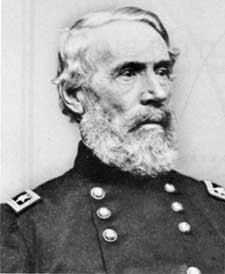 Maj. Gen. Edwin V. Sumner. From photograph by Brady or assistant. Courtesy, Library of Congress. |
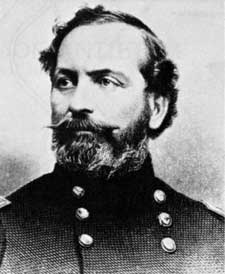 Maj. Gen. John Sedgwick. |

|

|
|
Last Modified: Mon, Mar 4 2002 10:00:00 pm PDT |


